Day 2 of a 2 day Private Tour today. Once again, we planned to have a day of general birding along the North Norfolk coast. We met up in Wells and this time headed west along the coast.
By the road, on the north side of Holkham Park, we spotted a Barn Owl perched on a post. A nice start to the day, but we were slightly spoiled by the number we saw yesterday. A little further along, a white shape up in the trees was not another owl but a very pale Common Buzzard. This bird is often to be found here and frequently catches people out as it is so strikingly white below. Whilst Buzzards are normally rather brown, they can be very variable in appearance and paler birds seem to be increasingly seen.
 Common Buzzard – a strikingly pale individual
Common Buzzard – a strikingly pale individual
We cut across inland towards Choseley. There have been up to three Rough-legged Buzzards in the general area and we had hoped to run into one of them, but we didn’t see any sign on our way there. We stopped to scan the fields at Choseley and picked up a more typically toned Common Buzzard perched on a hedge. There were lots of Brown Hares in the fields. Two Mistle Thrushes flew up onto the wires and when they dropped back down into the field they were joined by a couple of Song Thrushes.
We had a quick drive round to see if we could find a Rough-legged Buzzard in any of the other places they like to hang out, without success. When we got back to Choseley, one had flown across and landed in a pine copse in the distance. It was not a great view, half concealed in the trees, but as it preened itself we could see its white tail with black terminal band. With the weather forecast to deteriorate by the middle of the day, we decided not to hang around waiting to see if it would emerge again, and drove on down to Titchwell.
The overflow car park was already starting to fill up with cars and was consequently quite disturbed. We could hear Bullfinches calling as we walked round, but they flew off towards the back of Patsy’s Reedbed as we got there.
The feeders by the Visitor Centre were more productive. There were lots of Chaffinches, Greenfinches and Goldfinches flitting in and out and as we watched them, a Brambling appeared as well. It was rather nervous, but hung around long enough for us to get it in the scope. A grey-brown tit flew in, grabbed a seed and disappeared back into the bushes. Just enough time for us to see it was a Marsh Tit. It came in a second time and lingered a fraction longer. Then a Coal Tit flew in as well and helpfully perched for a few seconds in the bushes above the feeders.
 Brambling – on the feeders by the Visitor Centre this morning
Brambling – on the feeders by the Visitor Centre this morning
As we walked out towards the reserve, we scanned the ditches either side of the path, carefully looking for any movement. We were rewarded with a Water Rail, which scuttled across an open patch of water and then spent some time probing in the leaf litter in the dense tangle of branches under some bushes. It was remarkably well camouflaged and hard to see when it wasn’t moving, but we got a good look at it, noting its long bill, black-streaked brown upperparts and black and white barred flanks.
We stopped to scan the still drained grazing marsh pool, which looked rather devoid of life at first, apart from a solitary Teal in one of the deeper puddles at the front. Seeing some movement right over in the far corner, we turned the scope on it to see a couple of Rock Pipits out on the mud. As we scanned across, we could see there were at least three Water Pipits as well. It was great to see the two of them in the same scope view – the swarthy Rock Pipit with heavily streaked, dirty underparts compared to the cleaner Water Pipit with more restricted streaking on much whiter underparts and a more obvious whitish supercilium.
The freshmarsh is still flooded at the moment, so there were comparatively few waders out there again today. There were plenty of ducks though, and on one of the few small islands poking out of the water we picked out a little group of four Red-crested Pochards – two males and two females – asleep.
 Red-crested Pochard – roosting on one of the few remaining islands
Red-crested Pochard – roosting on one of the few remaining islands
We decided to head straight out towards the beach and come back to the hides later, in case the weather turned. The Volunteer Marsh was fairly quiet, apart from a good number of Shelduck and a few Redshank. However, at the end of the channel by the path was a large flock of Teal. Several of the drakes were displaying, throwing their heads back and calling.
 Teal – lots of the drakes were displaying today
Teal – lots of the drakes were displaying today
There were more waders out on the Tidal Pools. One of the first we got onto when we arrived was a rather pale Redshank-sized bird feeding in the deep water at the back. We got it in the scope and we could see it had silvery-grey upperparts spotted with white and shining white underparts; its bill was longer than a Redshank with a needle-fine tip. It was a Spotted Redshank in winter plumage, one of a very small number that spend the winter here (the majority just pass through on migration).
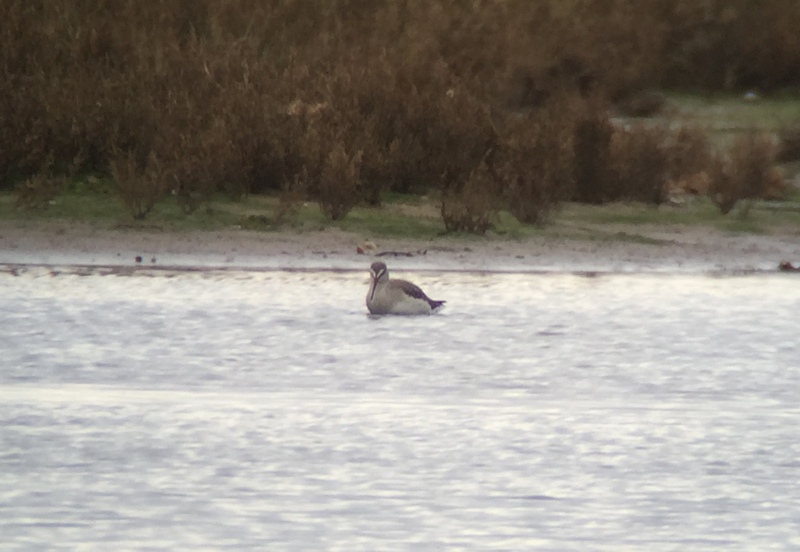 Spotted Redshank – feeding in deep water at the back of the Tidal Pools
Spotted Redshank – feeding in deep water at the back of the Tidal Pools
There seem to be rather fewer Black-tailed Godwits on the reserve at the moment, but several are still feeding out on the Tidal Pools – and as usual they were showing very well. We spent some time watching them, noting their long and very straight bills and plain grey upperparts. A little further along we found a couple of Bar-tailed Godwits as well – paler, with dark streaks on their upperparts and a slight upturn to the bill.
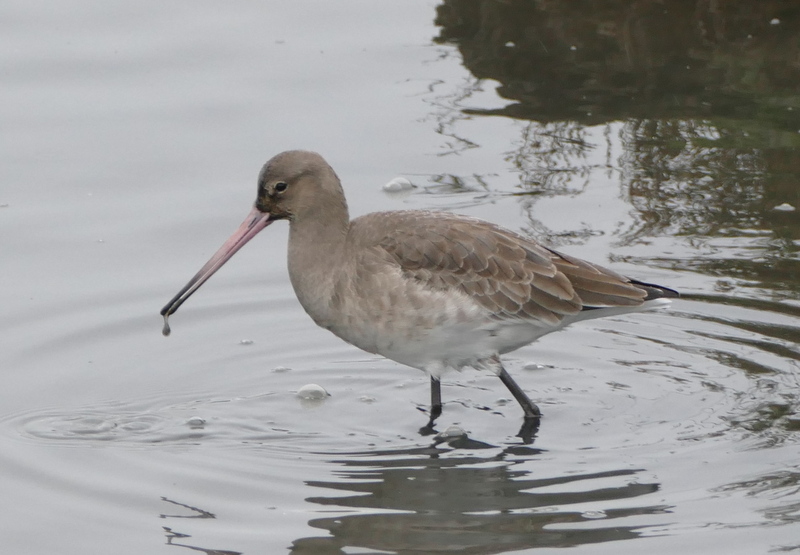 Black-tailed Godwit – showing very well on the Tidal Pools
Black-tailed Godwit – showing very well on the Tidal Pools
We also found a small group of Knot, in plain grey winter plumage, a little larger and dumpier than a Dunlin with a shorter, straight black bill, grey-green legs. A Turnstone was on one of the sandbanks, much darker than the other waders, with a short bill and orange legs. A large group of Oystercatcher were roosting on one of the spits.
While we were looking through the waders, a rakish, streamlined duck appeared overhead. It was a redhead Goosander, with rusty head neatly demarcated from its white underparts, grey above with an obvious white panel in the wings. It circled a couple of times, appeared to head over to the freshmarsh before coming back – it seemed to think about landing on the Tidal Pools before disappearing away to the east. They just pass through along the coast here. Coming in now is perhaps a sign that it is getting colder on the continent.
There were a few other ducks out on the Tidal Pools. A female Goldeneye was diving constantly, in among the Little Grebes. It was a challenge to get her in the scope, but when we did we could see her golden-yellow eye. Three female Pintail were upending in the shallows whereas the smart drake was keeping to himself in the deeper water.
Out on the beach, the tide was in. It had started to drizzle lightly and the wind had picked up, but we found some shelter in front of the dunes. Out on the beach, a little group of silvery-grey and white Sanderling were running around like clockwork toys. A scan of the sea revealed a small flotilla of Common Scoter not far out. It was not the weather to be out on the beach so, before we got too cold, we decided to make our way back to the hides.
 Avocet – a few of the 27 at Titchwell today, braving the winter here
Avocet – a few of the 27 at Titchwell today, braving the winter here
From the shelter of the Parrinder Hide, we took the opportunity to have a better scan of the freshmarsh. There were a few waders clustered around the few remaining slivers of island. A grand total of 27 Avocets are still hanging on, having made the decision not to head south for the winter. They were mostly asleep. A Common Snipe ran across the island behind them and stood for a while on the edge of the vegetation where we could see it. A single Golden Plover was hiding in with the Lapwing and several Dunlin and Turnstones were running in and out of the roosting ducks.
There were plenty of wildfowl. Lots of Teal were roosting around the edges, along with a smattering of Wigeon. There was a good number of Shoveler and in amongst them a few Gadwall and more Pintail. A handful of Brent Geese flew in to bathe and preen, vastly outnumbered today by lots of very noisy Greylags. Another Water Pipit dropped in very briefly for a bath, on the near edge below the hide.
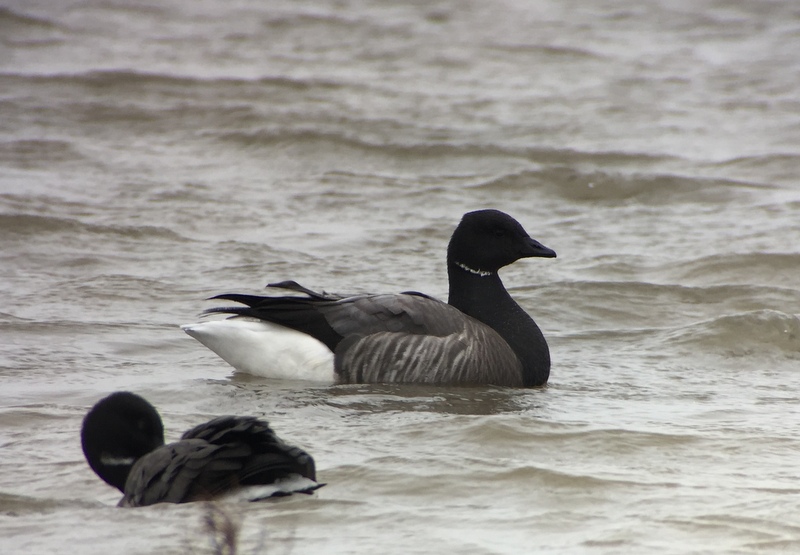 Brent Goose – a small number were bathing on the freshmarsh
Brent Goose – a small number were bathing on the freshmarsh
Having warmed up, we made a quick dash back to the shelter of the trees, diverting round via the Meadow Trail towards the Visitor Centre. The bushes here were quiet today, apart from a Song Thrush singing from the trees. While we stopped to get a hot drink, we had another scan of the feeders. A single Lesser Redpoll flew in to feed. Walking back to the car park, a couple of Chiffchaffs were flitting around below the bushes by the path. More commonly a summer visitor, a few increasingly spend the winter, though these are probably birds escaping south from Scandinavia rather than ones reared here.
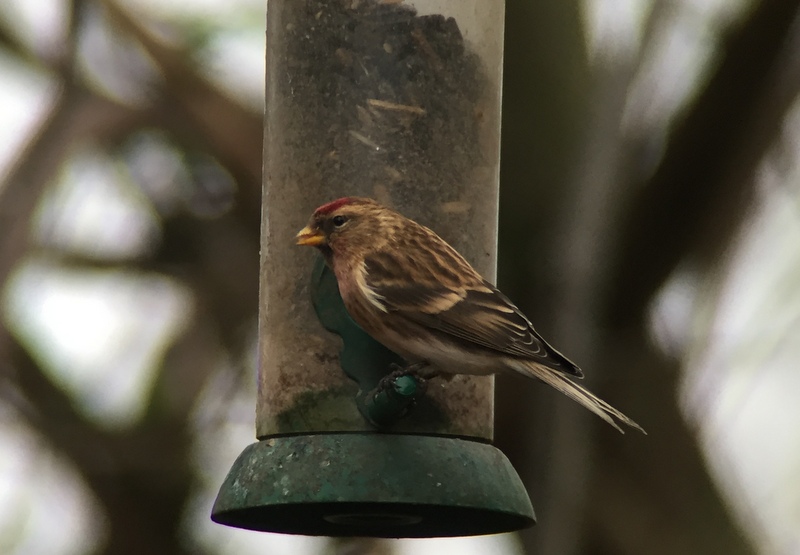 Lesser Redpoll – on the feeders in front of the Visitor Centre
Lesser Redpoll – on the feeders in front of the Visitor Centre
While we ate a late lunch, the rain started to fall properly, just as it had unfortunately been forecast to do. At least we had made the most of the morning. After lunch, we made our way back east along the coast.
We stopped at Brancaster Staithe to scan the harbour from the comfort of the car. In the channel right in front of us, a large group of eleven Red-breasted Mergansers were feeding, diving non-stop. In with them was a very pale, winter plumage Great Crested Grebe.
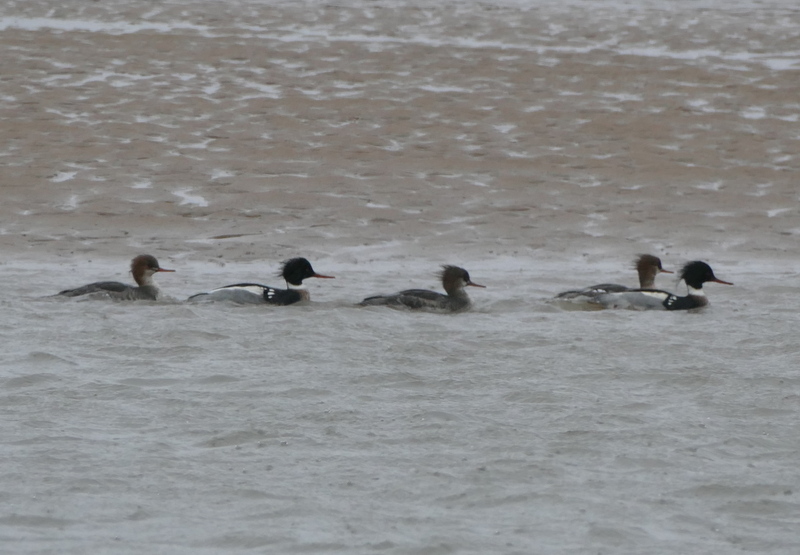 Red-breasted Mergansers – a group of 11 were off Brancaster Staithe
Red-breasted Mergansers – a group of 11 were off Brancaster Staithe
There was also a good selection of waders to look at. A Ringed Plover and a Grey Plover were both new ones for the day. We could see a few scattered Bar-tailed Godwits but when they took off and flew round together there were seventeen of them, along with a similar number of Dunlin. Several Turnstones were running around the car park between the cars.
We carried on east to Holkham, scanning the marshes on the way, and stopped on Lady Anne’s Drive. Lots of Brent Geese were feeding in the fields, along with a small group of Pink-footed Geese. The original plan had been to have a look in the pines this afternoon, with a particular request to see a Goldcrest. While there had been one with the Chiffchaffs at Titchwell, it had moved through too quickly for everyone to get onto it. The afternoon was already getting on by now, so with nothing to lose, we decided to brave the rain and go for a walk.
The trees were rather quiet at first, and we were almost to Salts Hole when we heard some tits calling from the trees. Working our way in, we came across a little group of Long-tailed Tits feeding low down in a bare tangle of brambles. The tits are often in mixed groups with other birds at this time of year, so we had hoped that something else might come out to join them, but as the Long-tailed Tits moved through it appeared that they were alone. Back on the main path, we could hear a Goldcrest and Treecreeper calling, but we couldn’t locate them in the rain and wind.
Salts Hole itself held a single female Goldeneye and at least four Little Grebes, all diving constantly. We carried on a little further and could hear more Goldcrests calling in the holm oaks but again could not get onto them. Further along the path was very exposed to the wind so, with the light failing fast, we decided to head back. A short way along, we heard more crests calling and stopped to listen. Eventually we saw three birds chasing each other across the path, silhouetted against the sky. One was still in the bushes above the path and we tried hard to get a better look at it. It was right above our heads and started calling – it was a Firecrest! Unfortunately, it was now just too dark to see it properly, particularly as it wouldn’t come out of the holm oaks.
We decided to call it a day and walked back towards the car. As we did, we could hear the Pink-footed Geese flying in to roost, a cacophony of yelping as thousands of geese flew in from the fields inland and whiffled down onto the grazing marshes for the night. There were several waves which arrived and once we got out of the trees we could see yet more geese dropping out of the sky through the gathering gloom and rain. We could just see a vast horde spread across the grass through the gaps in the hedges.
It had been a great couple of days out, but this seemed like a fitting way to end so we headed for home.
















